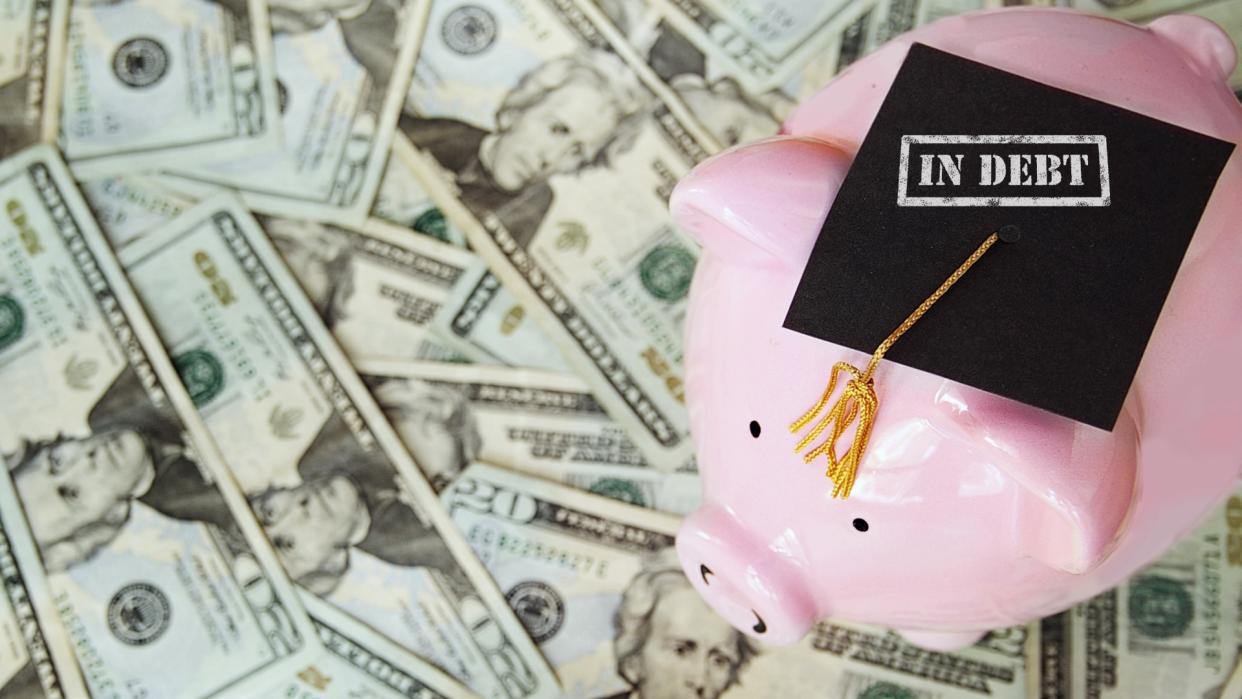This Group of Americans Has the Most Total Student Loan Debt — and Here’s How They Should Be Handling It

Student loan debt is a burden faced by many Americans, but it disproportionately affects certain age groups. Surprisingly, it’s not recent college graduates struggling the most. In fact, according to a recent study conducted by The Motley Fool, Americans 35 to 49 carry the heaviest student loan debt amounting to a staggering $636.2 billion among 14.7 million borrowers — surpassing every other age group for total student loan debt. Various factors including parental pressure, interest rates and other financial responsibilities contribute to this disproportionate burden.
Read: Student Loan Pause Officially Ends in October — Are You Ready To Start Making Average $503 Payments Again?
Student Loan Forgiveness: 10 Expenses To Cut From Your Budget When Payments Resume
Americans in the 35-49 Age Group Are $636.2 Billion in Debt
The Motley Fool survey highlights that Americans 35 to 49 are grappling with the highest student loan debt, reaching $636.2 billion among 14.7 million followers.
Age Group | Total Federal Student Loan Debt | Total Borrowers | Average Student Loan Debt by Age |
24 and Younger | $99 Billion | 7.2 Million | $13,750 |
25 to 34 | $494.6 Billion | 15.1 Million | $32,755 |
35 to 49 | $636.2 Billion | 14.7 Million | $43,279 |
50 to 61 | $296.4 Billion | 6.5 Million | $45,600 |
62 and Older | $110.5 Billion | 2.7 Million | $40,926 |
Contrary to what you might think, younger Americans carry lighter loan debt with those under 24 having only $99 billion in federal student loan debt (7.2 million borrowers). Even the age group of 25 to 34, which accumulates the second-highest total loan amount, has nearly $150 billion less in debt than their older counterparts. This group is burdened with $494.6 billion in debt (15.1 million borrowers). Further, those ages 50 to 61 have $296.4 billion in federal student loan debt (6.5 million borrowers), while those 62 and older have $110.5 billion in loan debt (2.7 million borrowers).
It’s interesting to note that the 50-61 age group actually has the most debt per borrower at over $45,000, just edging out those in the 35-49 range.
See: All of the States That Will Pay Off Your Student Loans
Interest Rates Are Likely To Blame
Despite making regular loan payments, 35- to 49-year-old Americans face many challenges due to rising interest rates. These rates hinder their process of repaying their loans.
“It is not surprising that 35-49-year-olds have the most student loan debt,” said Jay Zigmont, PhD, CFP® and founder of Childfree Wealth. “If your student loans have a 6% interest rate, they will double every 12 years if you ignore them. 35-year-olds have probably just hit their first doubling, and 49-year-olds may have hit their second.”
For those who opted for different payment plans, the situation may be even bleaker.
“The problem is that if you are deferring payment, or paying on an income-based program, you may not even cover the interest, so the loan keeps growing (except for the recent COVID forbearance period),” Zigmont said.
Societal Pressure and Population Growth
The expectations faced by today’s 30- to 40-year-olds, coupled with population growth, have influenced their approach to addressing student loans. Unlike older generations, who may not have emphasized college education as much, individuals in the 35-49 age group were more likely to prioritize it due to parental encouragement and societal trends.
How To Combat Student Loans in Your 30s and 40s
While combatting student loans in your 30s and 40s may seem daunting, strategic planning and disciplined financial habits can help you regain control of your finances and live a debt-free life.
Consider an Income-Driven Repayment Program
To prevent your loans from continually accruing interest, explore new repayment programs that offer more options for loan payments.
“The new income-driven repayment program can not only lower your payment but will stop interest from accruing, which means your loans will stop growing,” Zigmont said. “The new program is slated to cap payments at 5% of discretionary income for undergraduate loans, and your loan could be forgiven at the end.”
Budget
Regaining control of your debt may require a few months of frugal living, but it paves the way for a debt-free future. Create a comprehensive budget that allocates income toward essential expenses while prioritizing loan repayment. Identifying areas where you can cut back on nonessential spending will help you focus on debt repayment.
Prioritize Paying off Loans
While easier said than done, the best way to free yourself from the burden of student loans is to eliminate them. Stay disciplined and prioritize paying off the loans with the highest interest rates first.
“With interest rates currently being on the rise, refinancing is not likely to help as it combines all of your loans to the new rate,” Zigmont said. “You may want to consider following the avalanche method and paying off the student loan with the highest interest rate first, lowering your overall interest.”
Ask the Experts
Seeking help is nothing to be ashamed of. If you’re struggling to manage your expenses and feeling overwhelmed by loans, consider consulting a financial advisor. They can provide personalized guidance tailored to your specific circumstances, helping you develop a payment plan customized to your situation.
More From GOBankingRates
Major Cuts to Social Security Are Back on the Table -- What's Being Proposed Now?
Financial Insight in Your Inbox: Sign Up for GBR's Daily Newsletter
What's the Best Small Business in Your State? Vote For Your Favorite
This article originally appeared on GOBankingRates.com: This Group of Americans Has the Most Total Student Loan Debt — and Here’s How They Should Be Handling It
